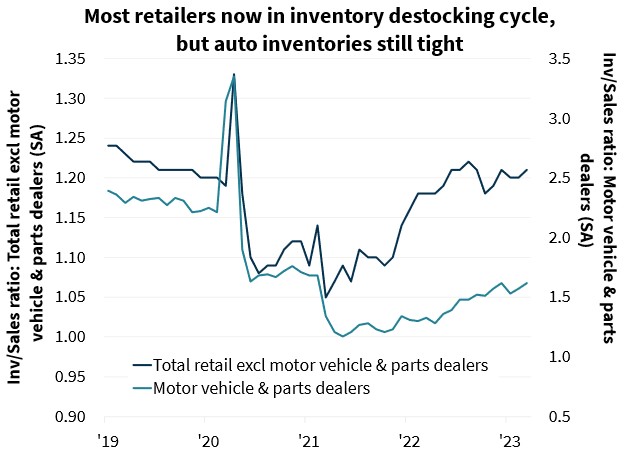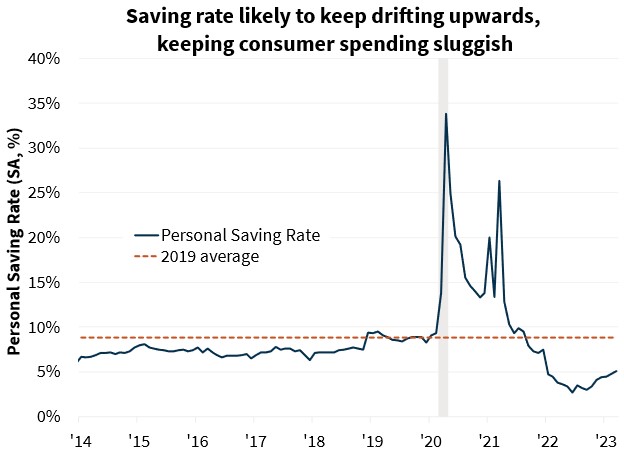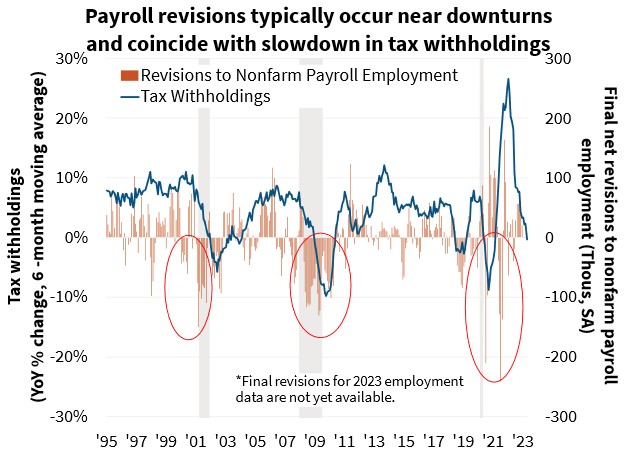Economy Still Expected to Slow, but Housing Construction Looking More Upbeat
Our economic forecast is little changed from last month, with modest revisions largely stemming from the details of the Q1 2023 Gross Domestic Product (GDP) report and an upgrade to new single-family home construction due in part to more upbeat outlooks from homebuilders. Both the April employment and Consumer Price Index (CPI) reports came in close to our expectations, and the Federal Reserve delivered an anticipated 25 basis point rate hike at its last meeting. Therefore, our outlook remains largely unchanged, including our expectation of a modest recession beginning in the second half of this year. While forecasting the timing of business cycle turns is challenging, we continue to expect that the effects of higher interest rates and tightening bank lending standards will eventually result in a contraction.
We now project real GDP growth on a Q4/Q4 basis in 2023 to be negative 0.3 percent, up one-tenth from our prior outlook. For 2024, we have downgraded growth by two-tenths to 1.2 percent. These slight annual changes stem from timing changes regarding business inventory restocking and housing investment. We forecast the unemployment rate to move upward to 4.2 percent by year-end and to rise to 5.3 percent by the end of 2024. Along with a slowing economy, we also forecast inflation to continue to decelerate, with headline and core CPI ending 2023 around 3.0 and 4.0 percent on a Q4/Q4 basis, respectively.
Our overall home sales forecast remains fundamentally unchanged with a slight upward revision of 2023 total sales to 4.86 million units (previously 4.84 million) and a slight downward revision in 2024 to 5.01 million units (previously 5.03 million). Our housing starts forecast was revised upward by a larger (though still modest) amount mostly due to a more positive outlook for near-term single-family starts. A modest upward revision to our purchase mortgage originations outlook, consistent with the home sales revision, was largely cancelled out by a downward revision to refinance originations. We project total originations for 2023 to be $1.65 trillion, essentially unchanged from our previous forecast of $1.66 trillion. For 2024, we anticipate volumes of $2.03 trillion, compared to our prior forecast of $2.02 trillion.
It should be noted that, while we are assuming that the ongoing debt ceiling impasse will be resolved in a manner that avoids a default by the U.S. government on its debt obligations, we believe there is a small chance that a technical default or some other macro-relevant disruption to non-debt government payments could occur, which could impact our forecast.
Uncommon Cyclical Economic Patterns
We began forecasting a 2023 recession in April 2022. At the time, this call was not based on any near-term indicator pointing to an inevitable contraction. Rather, it was largely due to the historical pattern of recessions typically being the end result of monetary policy tightening cycles. This is especially true when the Fed has reacted to inflation, as it is today, rather than moving proactively ahead of inflation. Historically, a meaningful rise in the unemployment rate, often coinciding with something “breaking” in the financial system, has been the way inflation is contained once it is well above target. We believe this to be currently playing out now, with the Fed continuing to cite a desire to loosen the labor market along with recent bank failures and growing weakness in commercial real estate. The second quarter Senior Loan Officer Survey showed a continued tightening in bank lending standards, which historically leads changes in outstanding bank business lending, and highlights how the effects of monetary policy tightening are continuing to work through the real economy via more restrictive credit.
That said, there are unusual aspects to the current economic cycle that suggest a soft landing is possible. Indicators such as non-auto industrial production, the ISM Manufacturing survey, and the Conference Board’s Leading Economic Index® all point to an upcoming downturn. However, two of the key channels in which rising interest rates affect economic activity is through demand for new autos and new home construction, and these sectors are currently not as rate sensitive as they have been historically. The auto sector is still recovering from pandemic-related supply shortages resulting in continued pent-up demand resilient in the face of higher rates. Even after a 7.7 percent jump in April, new auto sales remain around one million annualized units below 2019 levels. While business inventories broadly are in a destocking phase (inventory divestment dragged 2.3 percentage points on Q1 GDP), the auto industry inventory-to-sales ratio remains well below pre-pandemic levels, suggesting the need to build up additional inventory. Similarly, the ongoing lack of supply of homes for sale continues to drive demand for new home construction despite higher mortgage rates. Taken together, the auto industry and new housing market may disrupt the typical patterns that would normally lead to a recession. The case for a “soft landing” likely includes employment in the housing and auto industries holding up well despite higher interest rates because of the supply constraints and pent-up demand described.
More Likely a Matter of Time
However, we still believe a recession is more a question of when than if. A weaker response in the traditionally rate-sensitive sectors may mean that restrictive monetary policy will need to weigh on other sectors for longer to achieve the same reduction in inflation. We see the conditions in the housing construction and auto sectors as likely being more of a buffer to the severity of a recession by being potential drivers of eventual recovery than a means to prevent one.
Fundamentally, we see two dynamics in play: 1) We believe the Fed is unlikely to be convinced that inflation is under control until the labor market softens sufficiently, so we think it probable that policy will remain tight until a contraction is under way; and 2) Consumers continue to spend at levels that are historically high relative to incomes due to previously being able to draw down built-up pandemic-related savings, which is not sustainable. Even though spending and incomes have gradually drifted into better balance since October, the saving rate remains several percentage points below pre-pandemic levels. Therefore, consumption growth is expected to be sluggish relative to income growth, leaving overall economic growth vulnerable to contraction.
Underlying core inflationary pressures are probably weaker than the reported 5.5 percent annual core CPI growth rate in April due to lagged timing effects in measured shelter inflation, but they are likely still above the Fed’s 2 percent target. The more troubling component of core CPI remains in the core services components, where elevated prices are related to high wage pressure. Given the weak recent trend in productivity growth, current wage growth is too high to be consistent with the Fed’s inflation target. The Q1 2023 Employment Cost Index (ECI) accelerated modestly on a Q/Q basis and was up 5.0 percent annually. The unit labor cost measure from the productivity report, which was up 5.5 percent year-over-year in Q1, is also consistent with a core inflation trend well above the Fed’s target. We expect wage growth to decelerate in coming months as small business survey data suggests. However, we believe the Fed does not want this underlying core inflation pressure to persist long enough to effect longer-run inflationary expectations such that ongoing inflation risks becoming self-fulfilling. Given the Fed’s stated desire to see concrete evidence of labor market softening, we see a recession at some point in the foreseeable future as being probable.
To date, labor markets have remained quite resilient with 253,000 jobs added in April, and previous suggestions that a turning point was near have not played out. While continued labor market strength suggests no imminent downturn, employment in general is a lagging indicator, and there are some signs of weakening. Job openings have declined by more than 1.6 million over the past three months. Temporary employment, a generally leading indicator of broader labor market trends, remains in decline. Furthermore, continuing unemployment claims, though still low at an absolute level, have been trending upward. It remains to be seen whether these signals are reflected in nonfarm payrolls, but these weaker indicators would be consistent with a labor market on the verge of turning over. Additionally, while this does not point to an imminent recession, historically when economies do turn into a contraction, there is significant eventual downward revision to initially reported employment gains via changes in the estimates regarding the number of firm “births” and “deaths.” As such, the current readings of strong payroll growth are not incompatible with a downturn developing in the second half of the year. In fact, a hard data measurement of payroll and income tax withholdings suggest that the labor market may be turning.
Home Sales Remain Subdued but New Construction Holding Firm
Existing home sales pulled back in March by 2.4 percent, in line with our expectations, to an annualized pace of 4.40 million. Pending home sales, which lead contract signings on average by 30-45 days, declined 5.2 percent, pointing to a further sales slowdown in April and May. While mortgage rates have pulled back modestly from their highs in early March, ongoing affordability constraints, a lack of inventory for sale, and the ongoing persistence of a “lock-in effect,” where existing homeowners with low mortgage rates are disincentivized to sell their homes, will likely keep sales subdued for the remainder of the year. We left our existing home sales forecast essentially unchanged this month at 4.2 million units in 2023 and 4.4 million units in 2024.
The ongoing lack of existing inventory is continuing to bolster the demand for new homes. New home sales jumped 9.6 percent in March and have generally trended upward since the fall of 2022. While we expect sales to soften somewhat later in the year, consistent with our recession forecast, the new housing market appears to be more upbeat than it was to start the year. The National Association of Home Builders’ sentiment survey rose in May for the fifth consecutive month to a level of 50, denoting “neutral” market conditions. Additionally, many of the large publicly traded homebuilders discussed in their first quarter earnings calls a more upbeat outlook for the remainder of the year. A common theme was stabilization in prospective foot buyer traffic and the needed level of concessions and rate buydowns to drive sales. Land acquisitions and plans for further starts were guided upward. While we still expect tightening bank lending standards to limit construction going forward, especially among smaller and custom builders who tend to utilize smaller bank credit, on balance we have upwardly revised our new single family starts forecast for the year.
Multifamily housing starts pulled back in March by 5.9 percent, though the pace remained at a strong level of 559,000 annualized units. Multifamily construction has been surprisingly resilient in recent months. However, we still expect a large slowdown in activity later this year. Rent growth has slowed or even outright declined from a year prior based on some measures, while vacancy rates drifted upward. Furthermore, there is a record number of multifamily units currently under construction, which are scheduled to come online later this year and into 2024. Combined with tightening credit for construction lending, which we expect will soon be realized by a slower new project pipeline, we are expecting a significant slowdown in starts later this year.
Minimal Change to Mortgage Originations
We have only slightly changed our forecast for single-family purchase mortgage originations this month consistent with similarly small changes to our home sales forecast. We expect purchase originations to be $1.4 trillion in 2023 and $1.5 trillion in 2024, representing upgrades of $14 billion and $34 billion, respectively, from last month’s forecast.
In contrast we have slightly revised downward our forecast for refinances. We now expect refinances to be $291 billion in 2023 and $558 billion in 2024, representing downgrades of $21 billion and $26 billion, respectively. We note that refinance application activity remains subdued (see the Fannie Mae Refinance Application-Level Index, or RALI), but we expect refinances to pick up later in the year as mortgage rates fall slightly.
Economic & Strategic Research (ESR) Group
May 16, 2023
For a snapshot of macroeconomic and housing data between the monthly forecasts, please read ESR’s Economic and Housing Weekly Notes.
Data sources for charts: Federal Reserve, Census Bureau, Bureau of Economic Analysis, Bureau of Labor Statistics, National Association of Home Builders, Treasury Department, Fannie Mae.
Opinions, analyses, estimates, forecasts and other views of Fannie Mae's Economic & Strategic Research (ESR) Group included in these materials should not be construed as indicating Fannie Mae's business prospects or expected results, are based on a number of assumptions, including that the ongoing debt ceiling impasse will be resolved in a manner that avoids default, and are subject to change without notice. How this information affects Fannie Mae will depend on many factors. Although the ESR group bases its opinions, analyses, estimates, forecasts and other views on information it considers reliable, it does not guarantee that the information provided in these materials is accurate, current or suitable for any particular purpose. Changes in the assumptions or the information underlying these views could produce materially different results. The analyses, opinions, estimates, forecasts and other views published by the ESR group represent the views of that group as of the date indicated and do not necessarily represent the views of Fannie Mae or its management.
ESR Macroeconomic Forecast Team
- Doug Duncan, SVP and Chief Economist
- Mark Palim, VP and Deputy Chief Economist
- Eric Brescia, Economics Manager
- Nick Embrey, Economist
- Nathaniel Drake, Economic Analyst
- Richard Goyette, Economic Analyst







